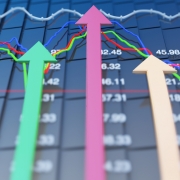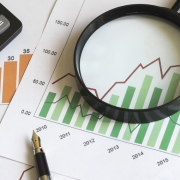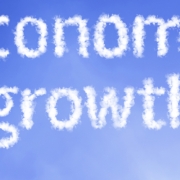We are all familiar with the government’s preferred measure of economic activity, which is GDP or Gross Domestic Product. It is a measure, primarily, of consumption. It’s preferred because it fits Keynesian theories about the role of government and the rationale for interventionist “stimulus” measures by central planners. The theory, in essence, goes like this: (1) consumption is the driver of economic activity; (2) when economic activity stalls or slows, it’s because there is a lack of consumer demand; (3) if the government puts more money in the hands of consumers, that will fix the problem; (4) government can do that by printing money, redistributing wealth and income from rich people who save to less rich people who spend, or taxing business to divert resources to consumers, or going into debt and diverting the debt proceeds to consumers, or creating government projects where workers can earn wages for doing government work. Of course, they do all these things.
The truth is the opposite. We must produce before we consume. In a healthy economy, business drives economic activity by building capital goods, making things, developing services, innovating and hiring. Consumer spending is a result of business activity, not a cause. Left to their own devices, without government intervention, businesses will generate a healthy growing economy.
What gets measured gets managed. Government measures GDP and then gears up its multi-pronged interventions when GDP growth lags.
But we can measure economic activity the right way, reflecting business activity not consumer spending. Professor Mark Skousen is the great proponent of the true measure of the health of the economy, Gross Output or GO. Here is aa recent article of his that appeared in the Wall Street Journal.
——————————————————————————————————————————–
The Bureau of Economic Analysis will release its preliminary first-quarter growth figure on Friday. According to the Atlanta Fed consensus tracker, economists are predicting gross domestic product to have risen at a meager 2% annual rate. But a powerful behind-the-scenes indicator suggests the real rate may turn out to be significantly higher.
“Gross output,” or GO, reflects the full value of the supply chain—the business-to-business spending that moves all goods and services toward the final retail market. Based on my work and research by David Ranson, chief economist at HCWE & Co., changes in the supply chain are a strong leading indicator of the next quarter’s GDP.
The supply chain, which the BEA calls “intermediate inputs,” took off in the fourth quarter of 2017, growing at a 7.5% annualized rate. That’s more than double the rate of real GDP growth and the fastest pace since before the Great Recession. Real GO, which includes both GDP and the supply chain, rose at a 4.7% rate. The growth was broad-based, with strong numbers in mining, manufacturing, utilities and construction. The fourth quarter 2017 GDP growth rate of 2.9% did not reflect the dramatic increases in intermediate outputs because GDP by definition measures only spending at the end of the economic chain.
The GO model is more in keeping with the Conference Board’s list of 10 leading economic indicators, which are linked to manufacturing and capital markets. For three quarters in a row in 2017, GO accelerated, probably due to the anticipated tax breaks and deregulatory environment. The boom in intermediate business activity should translate into higher economic growth soon, barring international instability, trade wars, or tighter-than-expected monetary policy.
As I noted in these pagesin 2014, measuring gross output is a breakthrough in national income accounting. By reporting GO as well as GDP, the BEA has helped economists catch up with the accounting and finance professions. Public companies have long reported the top line (revenue) and the bottom line (profit) at the same time each quarter. For a national economy, GO corresponds to the top line (total activity) and GDP to the bottom line (final product). As the economists Dale Jorgenson, J. Steven Landefeld and William Nordhaus wrote in a 2006 book: “Gross output [GO] is the natural measure of the production sector, while net output [GDP] is appropriate as a measure of welfare. Both are required in a complete system of accounts.”
GO also dispels the popular Keynesian myth that consumer spending is the driver of economic growth. For example, the New York Times recently warned: “With personal consumption accounting for nearly 70 percent of all economic activity . . . the administration will be hard pressed to lift growth substantially if consumers remain cautious about opening their wallets.” But GDP is an incomplete measure of economic activity. It overlooks the value of all goods-in-process, which amounted to more than $14.7 trillion in 2017.
The broader-based GO highlights the reality that business spending is actually substantially larger than consumption. Consumption is 69% of GDP but just 39% of GO, while business spending is 17% of GDP but 52% of GO. This model therefore better recognizes the vital contributions of entrepreneurship, capital investment and innovative technology. As Larry Kudlow, the new director of the National Economic Council, wrote in 2006: “It is business, not consumers, that is the heart of the economy. When businesses produce profitably, they create income-producing jobs and thus consumers spend. Capital formation is the key to worker productivity and consumer prosperity.”
The first-quarter 2018 GO release won’t come until July 20, but BEA director Brian Moyer says the agency plans to release both GO and GDP at the same time within the next year or two. Hopefully by then the media will catch on to this advance in supply-side national accounting and leading indicator of robust economic performance.
Mr. Skousen is a presidential fellow at Chapman University. He introduced gross output as a macroeconomic tool in his book “The Structure Of Production” (New York University Press).
Appeared in the April 24, 2018, print edition of Wall Street Journal.













